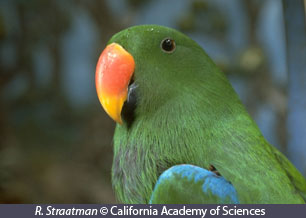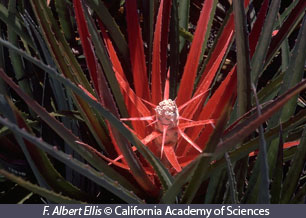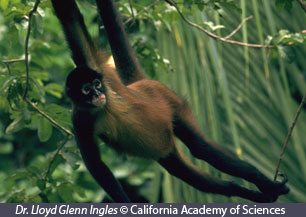|
Location | Weather | Plants | Animals | People | Links
 LOCATION: There are
two types of rainforest biomes: temperate and tropical rainforests. Temperate
rainforests are found along coasts in temperate regions. The largest temperate rainforests are on the
Pacific coast in North America, stretching from Alaska to Oregon. Other temperate
rainforests are found along the coast of Chile, the United Kingdom, Norway, Japan, New Zealand,
and S. Australia. Tropical rainforests are generally found between 30°N
and 30°S latitudes, covering 6 - 7% of the Earth’s land surface. Tropical rainforests
can be found around the world: In Central and South America; in Western Africa, eastern
Madagascar, and the Zaire basin; and in Indo-Malaysia along the west coast of India, Assam,
Southeast Asia, New Guinea, and Queensland, Australia. LOCATION: There are
two types of rainforest biomes: temperate and tropical rainforests. Temperate
rainforests are found along coasts in temperate regions. The largest temperate rainforests are on the
Pacific coast in North America, stretching from Alaska to Oregon. Other temperate
rainforests are found along the coast of Chile, the United Kingdom, Norway, Japan, New Zealand,
and S. Australia. Tropical rainforests are generally found between 30°N
and 30°S latitudes, covering 6 - 7% of the Earth’s land surface. Tropical rainforests
can be found around the world: In Central and South America; in Western Africa, eastern
Madagascar, and the Zaire basin; and in Indo-Malaysia along the west coast of India, Assam,
Southeast Asia, New Guinea, and Queensland, Australia.
WEATHER: Rainforests are important because they
help maintain global weather patterns and rain. Water that evaporates from trees falls in
other areas as rain.
Tropical rainforests are lush and warm all year long!
Temperatures don’t even change much between night and day. The average temperature
in tropical rainforests ranges from 70 to 85°F (21 to 30°C). The environment is
pretty wet in tropical rainforests, maintaining a high humidity of 77% to 88% year-round. The
yearly rainfall ranges from 80 to 400 inches (200 to 1000 cm), and it can rain hard. It can
downpour as much as 2 inches (5 cm) in an hour!
Temperate rainforests are also wet, but not as
rainy as tropical rainforests. It rains about from 60 - 200 inches (150 - 500 cm) each year,
while the other moisture comes from the coastal fog that lingers on the trees. The
fog provides about 7 - 12 inches (18 - 30°C) of rain each year. Temperate rainforests
are a lot cooler than tropical rainforests, but the temperatures are still mild. They
often have two distinct seasons: one long wet winter, and a short drier summer.
PLANTS: One type of plant often found in a rainforest
is an epiphyte. Epiphytes are plants that live on the surface of other plants, especially
the trunks and branches. They often grow on trees to take advantage of sunlight in the canopy.
In temperate rainforests common epiphytes are mosses and ferns, while in tropical rainforests
there are many kinds of epiphytes, including orchids and bromeliads. There are more than
20,000 varieties of orchids found in the rainforest.
There are about 10 -2 0 species of trees in temperate rainforests that
are mostly coniferous, meaning they have needles. Trees in temperate rainforests can
live much longer than humans, some live for up to 1000 years! Tropical rainforests
have a bigger variety of trees, hundreds of species in fact! These trees are mostly
broadleaf trees and have a shorter lifespan. They usually live for 50 - 100 years.
 Most trees in tropical rainforests have thin, smooth bark. They
don’t need thick bark to keep them from drying out because the rainforest is so wet. Also,
smooth bark makes it difficult for other plants, such as epiphytes, to grow on the tree surface. Trees
often have buttresses, large branching ridges near the base, for support because their roots
are often shallow and they grow tall to reach the sunlight. Prop roots also help support trees in
shallow soils. Many plants in the rainforests have adapted leaf shapes that help water drip
off the plant to avoid too much moisture, which might make bacteria and fungus grow. Most trees in tropical rainforests have thin, smooth bark. They
don’t need thick bark to keep them from drying out because the rainforest is so wet. Also,
smooth bark makes it difficult for other plants, such as epiphytes, to grow on the tree surface. Trees
often have buttresses, large branching ridges near the base, for support because their roots
are often shallow and they grow tall to reach the sunlight. Prop roots also help support trees in
shallow soils. Many plants in the rainforests have adapted leaf shapes that help water drip
off the plant to avoid too much moisture, which might make bacteria and fungus grow.
Tropical rainforests are so big that they are divided into four zones.
The top layer of the rainforest is called the emergent layer. Giant trees grow here that are
much taller than the trees below. The next layer is the canopy. It contains trees standing 60 to 150 feet
(18 to 45 meters) tall. Their branches form a canopy, like a big beach umbrella that shades the forest
floor. Thick, woody vines are found in the canopy. Over 2,500 species of vines grow in the
rainforest. Some vines, called lianas, are sometimes as big around as a person! They climb the
trees in the canopy to reach for sunlight. The next layer, the understory, is a dark, cool area
below the canopy, but above the ground. The understory is shaded from much of the sunlight
by the canopy. The forest floor is the bottom layer of the rainforest. This is the area where fallen,
decomposing plants and trees lay on the ground. Many insects live here. Temperate rainforests
have all of these zones except the emergent layer. The tallest trees in the temperate
rainforest canopy grow to be about 300 feet (90 meters) tall.
ANIMALS: Tropical rainforests are home to half the
plant and animal species on Earth. Scientists believe that there is such a great diversity
of animals in tropical rainforests because they are one of the oldest ecosystems on earth.
Some forests in Southeast Asia have been around  for
at least 100 million years, ever since dinosaurs roamed the earth. Animals in the tropical
rainforest are specially adapted to live in this unique environment. A common characteristic
found among mammals, birds, reptiles and amphibians, is an adaptation to living
in trees. One example is New World monkeys that have prehensile tails that curl around
branches allowing the monkey to hold onto the tree with its tail! Other animals are brightly
colored, sharply patterned, have loud vocalizations, and like to eat lots of fruit. Most
of the animals in the tropical rainforest live in the canopy. There is so much food available
up there that some animals never go down to explore the forest floor! Birds are important
to rainforests because they like to eat seeds and fruit. Their droppings grow into new plants
and help rainforests to survive. In turn, tropical rainforests are important to birds because
they provide winter grounds as migratory destination. Parrots are not the only type of birds
you will see in the rainforest. In fact, about 27% of the bird species in the world live
in tropical rainforests. Insects make up the largest single group of animals that live in
tropical forests. They include bright beautiful butterflies, menacing mosquitoes, camouflaged
stick insects, and colossal colonies of ants. for
at least 100 million years, ever since dinosaurs roamed the earth. Animals in the tropical
rainforest are specially adapted to live in this unique environment. A common characteristic
found among mammals, birds, reptiles and amphibians, is an adaptation to living
in trees. One example is New World monkeys that have prehensile tails that curl around
branches allowing the monkey to hold onto the tree with its tail! Other animals are brightly
colored, sharply patterned, have loud vocalizations, and like to eat lots of fruit. Most
of the animals in the tropical rainforest live in the canopy. There is so much food available
up there that some animals never go down to explore the forest floor! Birds are important
to rainforests because they like to eat seeds and fruit. Their droppings grow into new plants
and help rainforests to survive. In turn, tropical rainforests are important to birds because
they provide winter grounds as migratory destination. Parrots are not the only type of birds
you will see in the rainforest. In fact, about 27% of the bird species in the world live
in tropical rainforests. Insects make up the largest single group of animals that live in
tropical forests. They include bright beautiful butterflies, menacing mosquitoes, camouflaged
stick insects, and colossal colonies of ants.
In temperate rainforests you’ll find a different set of amazing
animals. Most of these animals live on, or near the forest floor where they are protected
from the wind and rain by the trees above. Many birds and small mammals, such as chipmunks,
like to eat seeds that fall on the forest floor. Lots of insects live in the temperate
rainforest. Most of them live in tree bark, decomposing dead plant matter, or mossy
areas. Birds and amphibians like to eat these insects. Some mammals in the temperate
rainforest include deer and bobcats. Cougars and bobcats are the top predators in this biome.
PEOPLE AND THE RAINFOREST: Tropical rainforests are
important because they provide oxygen, take in carbon dioxide, and are a huge source of
biodiversity and cultural diversity. However, people also rely on tropical rainforests for
food, medicine, timber, travel, and more. Rainforests around the world provide people with
food and spices, for example, allspice, vanilla, cacao, cassava, ginger, bananas, black
pepper, sugar cane, nutmeg and more. Many people are also moving from crowded cities where
they cannot find jobs into the rainforest where they are becoming small-scale farmers. With
all of this use, we need to be concerned about the stress we are putting on rainforests.
Thirty acres of trees are cut in tropical rainforests every minute! Some scientists estimate
that rainforests the size of Pennsylvania are lost each year. There are many causes of deforestation.
People are logging for firewood, charcoal, building materials and other uses. Trees are
being removed for commercial agriculture, which may cause permanent damage. Converting rainforests
to pasture land for cattle ranching has destroyed many rainforests. Mining for gold, bauxite,
and other minerals can destroy the land, and make it vulnerable to erosion.
What can you do to help our world’s rainforests? One way to start
helping is to learn more about the plants, animals and people, as well as the issues surrounding
rainforests and deforestation. When you learn about new issues, write letters to governmental
officials and the newspaper suggesting ways to help solve the problem. Practice conservation
at home. This will help reduce the use of rainforests, as well as ecosystems all over the
world. Bauxite is a mineral used to make aluminum. By recycling, you will reduce the need for
bauxite, which is mined in tropical rainforests. Pets from other countries may have been taken
from the wild or imported illegally from tropical countries. If you buy pets that are captively
bred in the United States, you will be sure that they didn’t come from the rainforest, or
another unique environment. Investigate the source of the wood for your furniture to see where
it comes from, and if it was harvested sustainably. All of these actions will help protect
rainforests all over the world.
LINKS:
Rainforest Education
Cool Planet: Tropical Rain Forest
Rainforest Species Profiles
Explore Africa's Rainforest
National Geographic: Rainforests at Night
Mongabay.com
Geography for Kids: Tropical Rain Forests
Tropical Rainforests: What’s it Like Where You Live?
|

